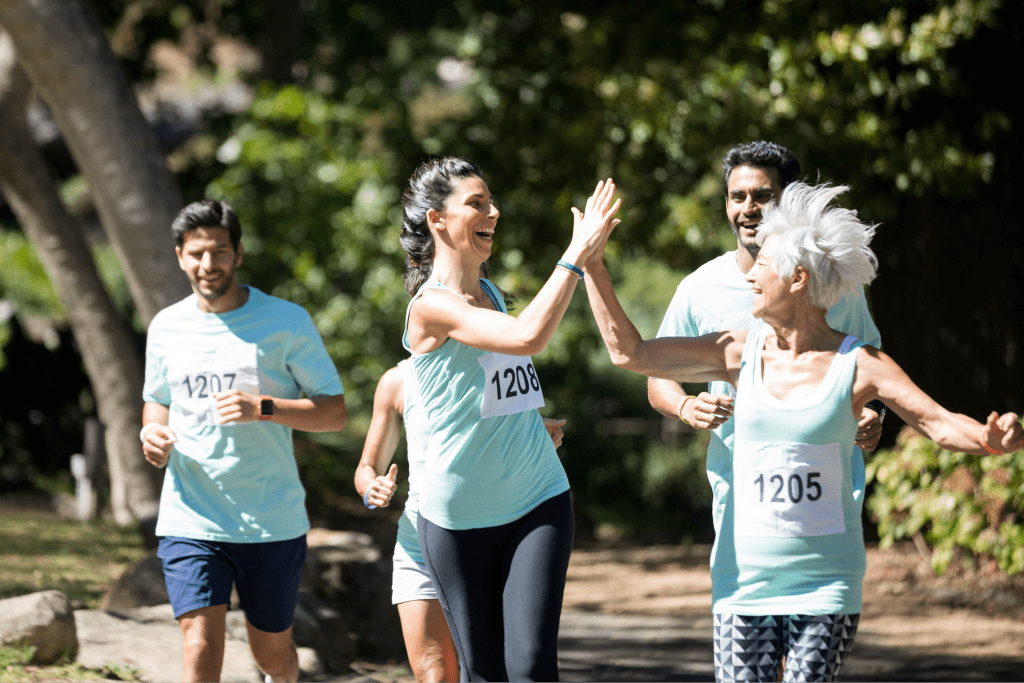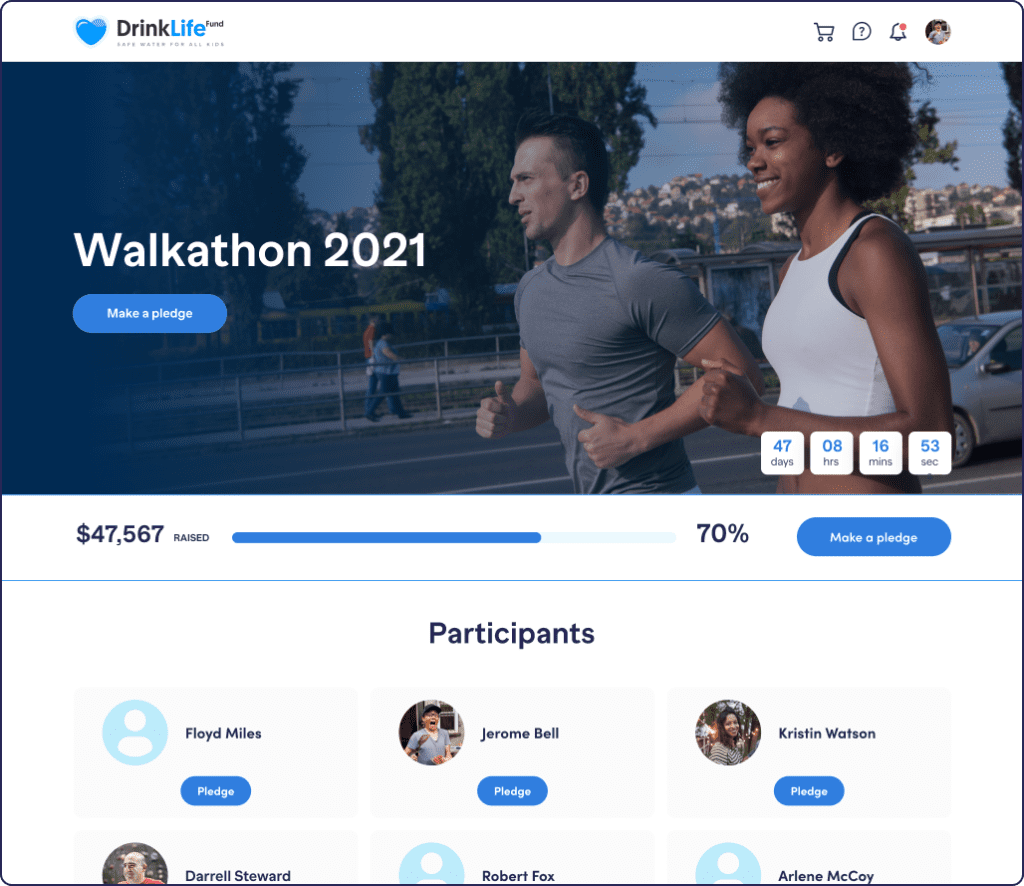Fundraising can be a challenge; while you want to raise as much money as possible for your organization, you want to be sure to do it in a way that engages donors, is simple and fun, and doesn’t place an undue burden on your staff and volunteers. It might seem like the perfect fundraiser doesn’t exist, but there is one type that checks all the boxes: a walkathon. Walkathons allow organizations to raise the money they need to do good in the world in a simple, fun way. Read on to find out more about what walkathons are, the benefits of choosing to host a walkathon for your next fundraiser, and the exact steps you’ll need to follow as you plan your next super fun, super engaging, super money-raising walkathon.
What is a walkathon fundraiser?
A walkathon is a classic fundraising type in which donors pledge a certain amount of money to participants for completing a set distance increment. For example, donors might pledge $1 for every lap around the track or $5 for every mile through the course that participants complete. To hold a successful walkathon, you’ll need to focus on engaging two distinct groups of people: your participants and your donors. We’ll share more about how to engage these groups later in the article.

What are the benefits of hosting a walkathon?
There are many benefits of hosting a walkathon.
- Walkathons are flexible. When you choose to host a walkathon, you can choose to host it in person, host it totally virtually or host it as a hybrid event. When you host a walkathon in person, you’ll have all your donors come together to complete their steps at a designated time. When you host a virtual walkathon, your donors will set their own course, report their own progress, and complete their steps all on their own. When you host a hybrid walkathon, you’ll ensure your donors have the option to participate in-person or virtually. With rapidly changing conditions and the inability to predict exactly what the future holds when it comes to in-person events, building flexibility into your fundraising activities is the smart thing to do!

- Walkathons are cost-effective. Unlike other large fundraising events like galas or concerts, there’s relatively little you’ll need to pay for upfront to ensure a high-quality event. When you choose to host a virtual walkathon, your costs will be even lower. Walkathons tend to have a very high return on investment and make for a cost-effective and fun way to raise money.
- Walkathons help you reach new donors. One of the best things about hosting a walkathon is that, because of its peer-to-peer design, you’re able to reach new donors that your organization has no previous connection. Not only will you be able to avoid the donor fatigue that can happen when you return to the same small pool of donors, again and again, to ask for money, but you’ll also get to spread awareness of your organization and the work you’re doing withing totally new circles. This awareness can encourage previously unconnected individuals to learn more and become involved with your organization in any number of ways; they may become a volunteer, may be excited to spread the word themselves, and may even become a long-term donor.
- Walkathons are fun and memorable. When you want to engage your biggest supporters, it’s important to plan fundraising activities that will be fun and memorable. Walkathons create opportunities for people to come together (if you choose to host an in-person walkathon) or to chart their own pathway and make memories as they go.
- Walkathons make it possible for everyone who wants to get involved to be a part of the action! While galas with hefty admission prices and big-ticket auctions can be great fundraisers, they can also feel exclusive and prohibitive due to the cost of entry. Walkathons allow everyone who wants to be involved to get involved. Whether someone’s network can help them raise $100 or $10,000, they’re welcome to join in the fun!
How do you host a walkathon?
Now that you know what a walkathon is and the many benefits of choosing to host one for your next fundraising event, you’re probably wondering how exactly to make it happen! Walkathons are generally simple to run, but you’ll need to make a plan and stay organized!
1. Choose a walkathon fundraising website
Before you start publicizing your event or recruiting participants, you’ll need to identify a walkathon fundraising website that meets your needs. The platform you choose matters because that’s where you’ll create both your fundraiser’s landing page and where participants will direct the people sponsoring them to give. When looking for a platform to host your walkathon, consider the following questions:
- Is the platform customizable?
When you’re creating your walkathon, you’ll want to be sure that the platform is totally customizable. It’s important for both participants and donors to be able to share a page that’s professional and branded totally to your organization.
- Is the platform user-friendly?
If participants can’t easily create their own pages to share and donors can’t easily give, your walkathon won’t be as successful as you hope. You’ll want whatever platform you choose to be simple to navigate and easy for you, your participants, and your donors to use!
- Can your participants easily share their giving page with their sponsors?
When it comes to peer-to-peer fundraising, it’s vital that participants be able to easily share their personalized giving page with their network. When participants share their page on their networks, they not only solicit donations they also raise awareness of your organization and the work that you’re doing.

2. Secure your walkathon day-of details
Your day-of details will look different depending on whether you’re hosting an in-person walkathon, a virtual walkathon, or a hybrid walkathon but, for each, you’ll want to consider the following questions and make sure you have answers before you begin to recruit participants or publicize your event.
For an in-person walkathon fundraiser, you’ll want to consider:
- Where will the walkathon be held?
- How will we manage event parking and logistics?
- Are we able to provide snacks, drinks, or other refreshments to participants and observers?
- How can we meaningfully engage sponsors throughout the event?
- Where will we recruit volunteers to assist with event logistics?
- What sort of swag do we want to offer walkathon participants?
- Are we offering incentives or prizes? If so, what are we offering incentives and prizes for?
For a virtual walkathon fundraiser, you’ll want to consider:
- How will we foster a sense of togetherness despite being physically apart from the event?
- How will we provide day-of support and encouragement to our participants?
- Will we provide swag to our participants? If so, how will we ensure it’s in their hands prior to the event day?
- How can we meaningfully engage sponsors throughout the event?
- Are we offering incentives or prizes? If so, what are we offering incentives and prizes for?
For a hybrid walkathon fundraiser, you’ll want to consider all of the questions listed for both the in-person walkathon and virtual walkathon. You’ll also want to determine how you can foster a sense of equity between virtual and in-person participants to ensure that individuals in both groups have a fun, memorable, and impactful experience.
3. Recruit participants
After you choose the perfect platform, customize your fundraising page, and secure your day-of details, you’ll need to recruit your participants: these are the people who will be walking in your walkathon and who will solicit donations from their friends, family members, and wider networks for their participation. There are several strategies you can use to recruit participants.
4. Help your participants engage their donors
Once you have finalized your platform and the details of your walkathon, you’ll want to start recruiting participants. Your participants are key to your success because it’s them who will be engaging their friends, family members, and social networks to give.
As a first step, you’ll want to reach out to all your active donors. An email appeal that lets them know about the event and calls them to participate can be effective. In your email, let your donors know that you appreciate all that they’ve done for your organization in the past, share the “why” of your walkathon (do you have a new project you’re hoping to fun? Do you need to serve more individuals than in years past? Have you formed new partnerships that demand more resources to make a change in your community?), and share the basic details of your event, including the different ways they can participate. You’ll also want to be sure that you’ll support them as they fundraise and share the ways you’re going to make it simple for them to raise money on your behalf.
Your email appeal might look something like this:
Dear (name)
We’re writing today because we want you to be the first to know about our First Annual Community Walkathon 2021. The First Annual Community Walkathon will help us get one step closer to ensuring that no child in our community will ever go to bed hungry.
The last year has been tremendously challenging for families, and we’ve seen a 46% increase in the number of families seeking regular food assistance. The funds you help raise through our First Annual Community Walkathon will allow us to expand our weekend meals program and send every hungry child home with a backpack full of food for the weekend.
The First Annual Community Walkathon 2021 is going to be a lot of fun: we’ll have music, food, giveaways, and, best of all, prizes for our tor raising walkers. We’re counting on you to take a step towards a more equitable community. Will you walk with us?
To sign up to walk and receive access to a full easy-to-use fundraising toolkit, go to (website.) We’re so grateful for the support you’ve shown in the past and look forward to walking with you this summer!
After you reach out to your existing donors, you’ll want to start spreading the word more widely. May organizations have success spreading the word and recruiting walkathon participants via the following channels:
- Social media.
- Local newsletters.
- Local event round-ups through the newspaper, news stations, or websites.
- Sororities, fraternities, and alumni groups.
- Aligned professional organizations.
- Other nonprofits that work in the same area or with the same population.
- Businesses and corporations with aligned strategic giving initiatives.
- Former volunteers and donors.
- Individuals currently or formerly served by the organization.
5. Support your participants all the way though
Your engagement with participants is just beginning when they click the sign-up button. In order to raise money effectively, you’ll need to provide them with ongoing support and resources. One of the easiest ways to do this is to set up an email campaign for all supporters that allows them to receive the information and support they need exactly when they need it.
A few emails that you might want to include are:
- A welcome email that thanks them for signing up and provides clear instructions on how to set up their individual fundraising page on your platform of choice.
- Weekly emails that prompt them to share specific messages or reach out to specific people in their circle. A sample schedule of weekly email prompts is below.
SIX WEEKS FROM WALKATHON DATE:
Hi (name),
You’re off to a great start. We’re so glad to see that you’ve set up your fundraising page and can’t wait to see how much you raise. This week we encourage you to share your page on social media and let your followers know why this cause is so important to you.
FIVE WEEKS FROM WALKATHON DATE:
Hi (name),
This week we encourage you to reach out to three people you went to high school or college with via email to share your fundraising page and let them know why this cause is important to you. Share a fond memory, invite them to give, and thank them for being there for you!
FOUR WEEKS FROM WALKATHON DATE:
Hi (name),
As we get closer to the big day, we’re encouraging you to reach out to three people that share your profession, whether they’re current colleagues, former co-workers, or professionals you’ve spent time within or out of the office!
THREE WEEKS FROM WALKATHON DATE:
TWO WEEKS FROM WALKATHON DATE:
ONE WEEK FROM WALKATHON DATE:
6. Host an awesome walkathon
With all the prep work behind you, it’s time to host a remarkable event that your participants and donors will never forget! Be sure to fully staff your walkathon with volunteers who know what they’re doing and create lots of opportunities for participants to have fun as they move. Some “extras” that can make participants feel extra special (and make your walkathon feel extra memorable) include:
- Leveled prizes that offer everyone the chance to bring something home.
- Photo booth stations.
- Snacks, drinks, and other refreshments.
- Music, entertainment, and special guests.
7. Say thank you (to everyone)!
No nonprofit fundraising event is over until every donor, volunteer, and participant has received a sincere thank you from the organization. Before you even invite participants to walk with you, you can automate thank-you emails to donors through your fundraising platform. You’ll want to show your appreciation to participants both verbally at the event and in writing later. Send a sincere email or letter letting them know how much their participation meant and the difference their contributions will make in the community. Be sure to thank your volunteers too, without them there’s no way most nonprofits could pull of large-scale events like walkathons with success!
Walkathons are highly effective fundraisers that help supporters join in the fun and have the power to raise a lot of money. With the right planning and passion, your next walkathon can be your best fundraiser yet!
